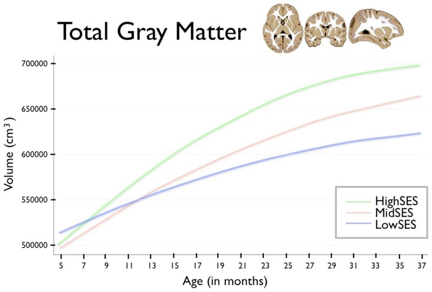Month 37
The brain is a self-organizing organ. The connections eagerly await new experiences that will shape the brain into the neural networks for language, reasoning, rational thinking, problem-solving and moral values.

Interestingly, the infants' brains look very similar at birth. You start seeing the separation in brain growth between the children who have had a stimulating environment v/s those that have been in an underprivileged conditions increase over time, which really implicates the postnatal environment.
The list of potential environmental factors is lengthy. Poor nutrition and lack of sleep, lack of books and educational toys, parental stress, an unsafe environment, and limited enriching conversation are just a few of the potential contributors

This figure shows total gray matter volume for group by age. Age in months is shown on the horizontal axis, spanning from 5 to 37 months. Total gray matter volume is shown on the vertical axis. The blue line shows children from Low socio-economic status (SES) households; children from Mid SES households are shown in red. The green line shows children from High SES households.
How I think @ 37 months
At this stage I enjoy learning new skills. I have the capability of learning language rapidly. I act more independently and have gained increased control of hands and fingers.
Motor Development: Gross Motor Skills
• I am well balanced
• I move well and quickly
• I can gallop in high, wide steps
• I can ride a tricycle
• I alternate feet when climbing stairs
• I put on and take off jackets with some help
Motor Development: Fine Motor Skills
• I can carry drinks without spilling
• I have some finger control in handling small objects
• Makes up-and-down, side-to-side, and circular lines with pencil or crayon
• Turns book pages one at a time
Language and Thinking Development
• I operate in the here and now
• I am excited, curious, and imaginative
• I know number concepts of one and two
• I understand, “It’s time to...”
• My attention span is four to eight minutes
• I can name and match simple colors
• I have difficulty combining two activities such as eating and talking
• I use letter substitutions such as “w” for “r”, as in wabbit for rabbit
• I use pronouns like he and she and prepositions like on, over, in
• My vocabulary is 800 to 900 words
• I understand two directions given one after the other
Social and Emotional Development
• I like to copy adults
• I am interested in playmates
• I pretend to be an animal
• I play alongside other children
• I am beginning to take turns
• I want to please adults, but am often independent
• I am spontaneous, lively, and talkative
• I go after what I want and fight for it
• I may be jealous
• I often get frustrated
Activities
Disclaimer: This presents an overview of child development. It is important to keep in mind that the time frames presented are averages and some children may achieve various developmental milestones earlier or later than the average but still be within the normal range of development. This information is presented to help parents understand, at a high level, what to expect from their child. Any questions/concerns you may have about your child’s development should be shared with your doctor.




